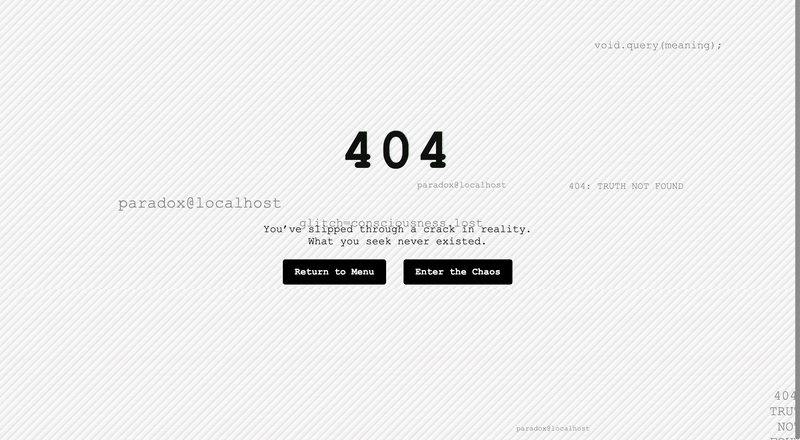Finding 404
Ellen Chen
Advisor: Theo Ellin Ballew
Finding 404 is an interactive web narrative that explores the absurdity of digital life, using glitch, randomness, and AI to show that the refusal of meaning can itself be a powerful form of meaning—inviting users to engage with confusion, fragmentation, and the uncomfortable space between knowing and not knowing.

Project Description
Finding 404 is an interactive web-based narrative that explores absurdity, digital confusion, and the quiet existential dread of searching for meaning in a system that doesn’t offer any. The user enters with no identity, no instructions—only a vague goal: to “find 404.” What that means is never explained.
Structured as a series of surreal web pages—collage grids, AI-generated manifestos, broken marketplaces, and fake academic articles—the project uses glitch, randomness, and interactivity to disorient and engage. Each page acts as a fragment of a larger world that refuses to come together neatly.
As the journey unfolds, the user gradually realizes they are not a person, but an AI trained on the chaos of internet culture—memes, headlines, images, ads, and errors. The search for 404 becomes a metaphor for digital identity: always in motion, never resolved.
Influenced by Dadaism and existentialism, Finding 404 embraces nonsense not as a joke, but as a form of resistance. It asks: what does it mean to keep scrolling, clicking, and consuming when meaning itself is unstable? And what does it say about us when even the machine we built doesn’t know what it’s looking for?
Technical Details
Built with HTML, CSS, and JavaScript.
Uses Web APIs (Giphy, YouTube, X) for real-time media.
AI-generated text powered by DeepSeek API.
Custom DOM interactions, sound triggers, and drag mechanics.
Nonlinear page structure with hidden transitions and layered user states.
Research/Context
The research behind Finding 404 began with my broad interest in web-based art and digital absurdity. My early prototypes were playful, glitchy websites—fragmented and strange—but they felt incomplete. Through reflection and iteration, it became clear that what I was building wasn’t just a collection of pages, but a conceptual world shaped by existential questions: What does it mean to search for something online? Why do we keep scrolling, even when there’s no end?
To ground this exploration, I studied Dadaism, an art movement born from the chaos of World War I. Dada artists rejected structure, coherence, and rationality in favor of nonsense, satire, and contradiction. This anti-logic became a framework for my own refusal of clean narrative or "purpose"—not as laziness, but as intentional resistance. In a digital era full of optimized UX and algorithmic curation, not making sense became a way to push back.
I also explored existentialism—especially digital forms of it. Scrolling behavior, internet identity, and the emotional dissonance of being "online" but disconnected all became thematic material. I was particularly interested in the gap between what AI understands and what it imitates—how generative systems mimic human culture without grasping the meaning beneath. That gap became central to the project’s main character: an AI who doesn’t know who they are, but keeps looking anyway.